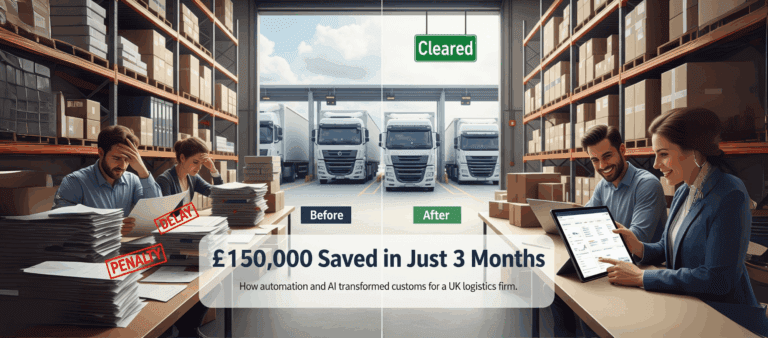Sort your ICS2 declarations in 90 seconds with AI
The Silent Burden: Why Your Compliance Team is Drowning in Manual Paperwork and How to Surface
- John Hall
- Customs Specialist at iCustoms.ai
Every minute spent hunting for a missing document is a minute your shipment isn’t moving.
Trade compliance teams know this better than anyone. Between keeping up with regulations, double-checking HS codes, and preparing customs declarations, their days are filled with manual, repetitive work, often using tools that just weren’t built for the job.
And when the pressure’s on, small mistakes can turn into costly delays. This blog looks at why manual compliance processes are a hidden burden and how your team can start to rise above them.
What do trade compliance teams deal with?
Behind every import or export transaction is a trail of documentation, including commercial invoices, HS codes, certificates of origin, packing lists, customs declarations, licenses, and more. And that’s just the start.
Now imagine:
- Each document type needing to be cross-checked against regulations.
- Every entry manually input into multiple systems.
- Errors discovered only at the point of audit or border control.
That’s the daily reality for many compliance teams, especially those still relying on spreadsheets, PDFs, email chains, and printed files.
A few common documents that drain time are:
- Import/export customs declarations
- Safety & security declarations (ICS2, S&S GB)
- Import/Export licenses
- Entry Summary Declaration (ENS)
- Documents like sanctions and embargoes
- Certificates of origin
- Other supporting documents like packing lists, insurance certificates, inspection certificates, etc.
Why are manual trade compliance processes a problem?
Let’s dig a little deeper into why sticking with paper-based, spreadsheet-driven compliance processes isn’t just outdated; it’s risky, expensive, and holding your business back.
It slows down everything
Manual trade compliance work is slow by nature. Just think about what happens behind the scenes:
- Teams copy-paste data from emails into declaration forms.
- They dig through Excel files to double-check HS codes.
- Someone prints documents just to re-scan them for customs submissions.
All of these tasks add a considerable time to your process, from hours to sometimes days.
When a shipment is ready but the documents aren’t, goods sit in warehouses or ports, racking up demurrage fees or missing delivery slots.
Chances of human errors
Even the most careful compliance professionals can make mistakes. When you rely on manual entry for data that feeds into customs declarations, certificates, and regulatory filings, you open the door to:
- Mismatched HS codes
- Wrong country-of-origin entries
- Missed license requirements
- Incorrect product descriptions
These errors can trigger customs rejections, audits, or financial penalties. And fixing these errors post-clear is even more time-consuming and stressful.
It is expensive (in the ways you don’t always see)
On the surface, using spreadsheets or paper may seem cheap. But hidden costs pile up quickly:
- Labour hours spent on low-value tasks like reformatting invoices or cross-checking license codes
- Costs of delays, like storage, rebooking freight, or lost sales
- Compliance fines, which can run into the thousands if documentation errors violate trade regulations
- Increased audit risk, which diverts even more internal resources
One wrong classification could lead to overpaying duty or underpaying and getting penalised during an audit.
It doesn’t scale with business growth
Manual processes might “work” when you’re shipping a few containers a week. But what happens when volumes double? Or when you expand into new markets with different customs rules?
Suddenly, your team is spending 80% of their time doing administrative work just to keep up. Hiring more staff may seem like a solution, but it’s not sustainable, especially when software can do the same work faster and more accurately.
Plus, training new employees to manually handle sensitive compliance tasks carries its own risks and learning curve.
Missed opportunities and risks
When your compliance documentation is spread across local drives, inboxes, paper files, or individual spreadsheets, it’s nearly impossible to get a clear picture of:
What’s been filed?
What’s pending?
Where are the delays or errors?
What are the duty costs by region or product?
This lack of visibility impacts day-to-day operations, for example:
You can’t quickly answer if a shipment complies with the new ICS2 requirements.
Your finance team can’t track customs-related costs across product lines.
You’re blind to patterns in recurring documentation errors.
Without centralised data, you’re constantly reacting to issues, not preventing them.
It makes adapting to new regulations harder
Customs regulations evolve, and often without much notice. Whether it’s the UK’s CDS replacing CHIEF, the rollout of ICS2 across the EU, or changing post-Brexit trade rules, compliance teams need to adapt quickly.
Manual systems aren’t flexible enough to accommodate rapid changes:
- Updating spreadsheets across regions is error-prone.
- Teams might miss rule changes that affect filing formats or data requirements.
- Compliance officers spend more time searching for guidance than acting on it.
In contrast, smarter, digital systems can embed new rules as they’re introduced, reducing the learning curve and risk of non-compliance.
Surfacing solutions: What needs to be changed?
The good news is that you don’t have to start a costly digital transition right away; little focused actions can have a significant impact:
1. Map out the process
Understand the workflow you currently use for documents. Where are the bottlenecks? Human touchpoints: where are they? A simple audit of your import/export procedures can help find the areas that are wasting time and raising risks.
2. Digitise the most repetitive tasks first
Seek out areas where automation can be helpful right away:
- Data extraction from packing lists and invoices
- AI-powered HS code auto-classification
- Verifying ENS or CDS declarations in advance of submission
These are low-reward, high-effort chores that automation can complete far more quickly.
3. Centralise document access
A single platform or digital archive, as opposed to a collection of emails, folders, and physical files, makes audits much simpler and helps ensure that everyone is working with the same version of a document.
4. Stay up-to-date on regulatory modifications
The system that provides regulation updates (such as modifications to ICS2 requirements or CDS customs processes), without requiring continuous human research, assists your team in maintaining compliance.
5. Invest in intelligent compliance tools
AI-enabled trade compliance software, such as intelligent document processing, auto-classification, and validation engines, is no longer limited to large multinational businesses. Mid-sized importers, brokers, and freight forwarders now have easier access to it thanks to cloud-based solutions.
Wrapping up
Manual compliance is draining time, energy, and money. It’s stressful, messy, and no longer suitable for today’s fast-paced trade environment.
The good news? You don’t need a massive overhaul. Start small, centralise documents, automate where it makes sense, and stay on top of regulations. With a few smart steps, your team can work smarter, not harder.
You may also like:
Simplify Customs with our Powerful Customs Management Software
Automate declarations, track shipments, & ensure compliance.
About iCustoms
Simplify Customs with our Powerful Customs Management Software
Automate declarations, track shipments, & ensure compliance.




